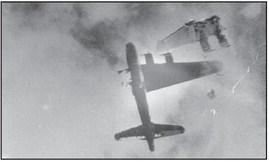In 1944, those in the military knew there would be a mammoth Allied invasion into Europe, they just didn’t know where or when. The job at RAF Molesworth Air Base was to bomb any Nazi manufacturing or any military force that could be used against the Allies. Ball bearing and aircraft plants were targets for the B-17 bombers as their flights over Germany were used to inhibit the Nazi war machine. The British made their bombing raids at night. The Americans made theirs during the day in an effort to make precision bombing of their targets.
As the war continued, the Nazis started launching V-1 buzz bombs and V-2 rockets into London and the surrounding area. While there is room to argue about how effective the V-2 rockets were as strategic weapons, they were very effective as a terror device. Those in London were very afraid because there was little they could do to defend themselves.
In the early morning hours of February 28th, 1944, the B-17 pilots met at the Molesworth Air Base. The mission that day was a bombing run to take out V-2 sites.
After the initial meeting, the crew would assemble on the tarmac and would go over the procedures of the flight. On extended flights, the crew needed heavy coats because at 20,000 feet the temperature was minus sixty degrees. The planes were not pressurized or heated. Crew members could plug in their flight jackets into the plane’s electrical system so their coats would create enough heat to keep them from freezing. The crew was also forced to breath oxygen from a mask.
As Noel Shoup and his bomber crew took off from Molesworth, they headed almost directly south and assembled into formation with other planes in the bombing mission. This mission would take them across the English Channel and toward Bois Conqueral, France. As they entered France, it became apparent that it would be too cloudy to see their targets and complete their bombing missions. At that time there was little weather information that could guide the mission ahead of time. The lead plane of the formation decided to turn back and the others in the group followed.
By that time, the Nazi gunners just off the coast of France, heard the bombers and from the sound of the planes started blindly firing into the clouds hoping to stop them. The bombers had almost turned around and headed back to Molesworth, when Noel Shoup’s B-17 was hit. The blast separated the left wing from the plane. Then, the nose was ripped from the plane as it was spinning down. The bombardier and navigator were thrown clear of the plane. The left waist gunner bailed out of the waist gunner window. Noel and six others were in the plane as it spiraled toward the ground. The plane then exploded.
The debris crashed near Translay, 13 km southwest of Abbeville, France with the remaining seven on board. The debris field was not very big as most of the plane and remaining crew came to earth in a farmers field. During the war there were no other planes that fell to earth in that area.
Since France was under Nazi control, the Germans recovered the remains and buried them in Abbeville. The Nazis did keep careful records. In 1945 the American forces used those records to unearth the buried remains and moved them to the United States Military Cemetery in St. Andre, France. Part of Noel’s remains have been there since the end of the war. (303rdbga. com/359shoup.html) With legislation being passed recently, the military was ordered to bring home as many of our heroes as possible. With this new initiative, the military visited Abbeville and asked if anyone remembered where a B-17 may have crashed. An older man in town knew exactly where it fell. That area was then carefully probed. It looked like an archaeological dig as the soil there was examined and sifted through. Additional bone fragments were found and a ring that was in almost perfect condition. The initials carved in the ring read N. E. S. The researchers knew they had found the Dublin High School ring belonging to Noel Emerson Shoup. The latest DNA matching technology has enabled researchers to identify remains with accuracy that was not available even 5 years ago. Those remains almost 80 years later will be coming home.
There will be a viewing for American Hero Noel Shoup Sunday, Sept. 10 at Harrell Funeral Home from 6-8 p.m. Noel will be buried after his service at 1 p.m. at Greens Creek Baptist Church with full military honors at the Upper Greens Creek Cemetery next to the church. This has been a long story for the family and some closure will finally take place with the proper honoring and burial of Noel. A special thank you to the brave souls and their families who have enabled the United States to be the greatest place on earth to live.
The Dublin Historical Museum will be open after Shoup’s service for people to view a special exhibit involving Noel’s history.
Visit us at dublinhistorical. org


